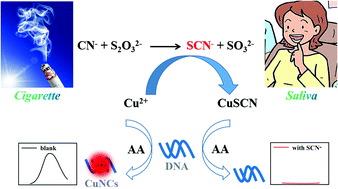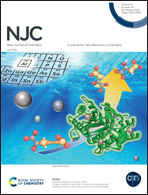Nano-fluorescent probes based on DNA-templated copper nanoclusters for fast sensing of thiocyanate
Abstract
Thiocyanate (SCN−) is a metabolite of cyanide detoxification, which is considered to be a biomarker of environmental tobacco smoke exposure. Herein, a simple, fast and label-free fluorescent sensor was developed to determine SCN− based on the in situ formation of DNA-templated fluorescent copper nanoclusters (CuNCs). Without SCN−, the Cu(II) ions in buffer were reduced by ascorbic acid and then accumulated on the DNA template, showing a high fluorescence. However, in the presence of SCN−, the Cu(II) ions reacted with thiocyanate and then the remaining unreacted Cu(II) ions were reduced by ascorbic acid, producing a small amount of the CuNCs and a weak fluorescence. Several important parameters such as the concentrations of DNA, Cu(II) ions and ascorbic acid were optimized. Under the optimized conditions, the linear range was 10–100 μM and the limit of detection (LOD) was 4.94 μM for thiocyanate assay. Due to the strong chelation between SCN− and the Cu(II) ions, high selectivity was achieved for SCN− detection by this sensor, with practical applications in real water and artificial saliva. The operation process is simple and the signal response of this method to thiocyanate is fast, within a few minutes. Therefore, the developed assay has great potential to determine thiocyanate for the assessment of water safety and human health.



 Please wait while we load your content...
Please wait while we load your content...